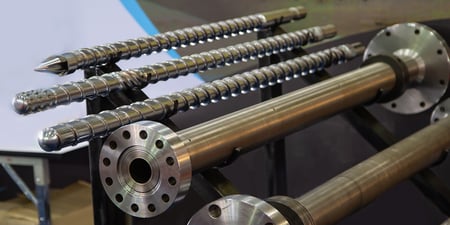
The feed throat is one of the most often overlooked parts of injection and extrusion processes. The feed throat is the area at the rear of the screw and barrel where the plastic pellets feed into the plasticating screw. This is also the area where gases from the molten material are vented out. The hopper or magnet box sits directly on the feed throat.
As would be expected, this area can be very hot. Its proximity to the rear zone of heater bands can drive the temperature up to levels that soften and begin melting the pellets a little too early in the process. This can result in the “bridging” of the feed throat.
Due to the excessive temperatures, the pellets travelling down the throat will start to melt and clump up. This can completely block the flow of resin into the screw and barrel and essentially run the machine out of material, while also blocking much of the flow of gas out of the machine. Removing the partially melted clump of material that blocks a feed throat can be both difficult and dangerous.
As is usually the case, prevention is the best corrective action.
Most (if not all) modern equipment have a separate water channel that flows around the feed throat to help maintain an acceptable temperature. There will be a set point option which is normally located on the same page as the barrel temperature zones. The desired temperature is achieved by the controller opening and closing a flow control valve. The optimum temperature setting can vary depending on the material you are running, but resist the urge to set it any lower than 130°F.
Colder is not always better. Too low of a feed throat set point can result in additional cycling of the rear barrel zones as well as the possibility of condensation introducing water into the material as it feeds into the screw.
A good rule of thumb for materials that are dried prior to processing is to set the feed throat temp at 20°F less than the drying temp. If you dry at 175°F set it at 155°F. Most materials will do fine at 130-150°F.
Learn how to reduce machine downtime with five quick purging compound tips for your injection molding application.

With over 30 years in the field, Jerry Weddell is a Technical Sales Representative with a wealth of knowledge in mold-making and purging compounds. While his expertise spans injection molding, extrusion, and blow molding, he is particularly distinguished in injection molding. Jerry's profound understanding of these processes enables him to offer targeted, practical solutions, especially in the nuanced aspects of injection molding. His commitment to providing exceptional guidance and support to clients has made him a respected and trusted figure in the industry.








Comments